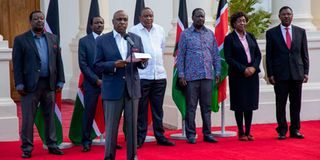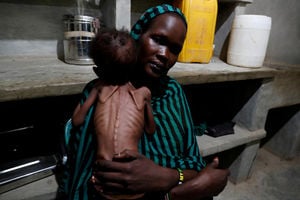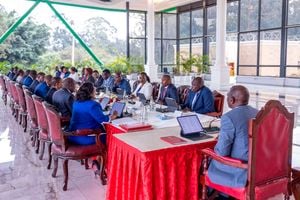Third force needed to join 2022 succession chess game

Baringo Senator and Kanu chairman Gideon Moi reads a statement after President Uhuru Kenyatta met with political party leaders at State House, Nairobi, on February 25, 2021. The meeting was attended by Mr Musalia Mudavadi (ANC), Mr Kalonzo Musyoka (Wiper), Mr Raila Odinga (ODM), Mrs Charity Ngilu (Narc) and Mr Moses Wetang’ula (Ford Kenya).
What you need to know:
- Kenyans are beginning to be sceptical about the advantages to be derived from a state led by a coterie of tribal kingpins.
- Mt Kenya region is restive due to the imminent departure of President Uhuru Kenyatta from office.
There is a raging battle between the “Handshake” group and the “Hustler” side for the soul of Kenya. A section of the Judiciary, faith sector, civil society and a few politicians form a third voice agitating for protection of the 2010 Constitution.
In this epic struggle, most Kenyans are by-standers oblivious of their constitutional Article 1 sovereign power. Historically Kenyans have been largely socialised to follow their tribal political elite on public matters.
Currently, the president is attempting to bring into one house Nasa/Oka and his former TNA/Kieleweke so as to create a formidable electoral machine from the Mt Kenya, Luhya, Luo, and Kamba communities.
However, this envisaged tribal alliance faces multiple challenges.
One: Will Kenyans, yet again accept to be herded into tribal kraals? Kenyans are beginning to be sceptical about the advantages to be derived from a state led by a coterie of tribal kingpins. As poverty bites, there are no discernible economic benefits to citizens from each ethnic baron.
Second, the Mt Kenya region is restive due to the imminent departure of the president from office. Regional political leaders such as Mwangi Kiunjuri, Mwangi Wa Iria, Moses Kuria as well as Martha Karua and CS Peter Munya have begun to chart their political future. Speaker Justin Muturi’s installation as Mt Kenya spokesperson has been contested by his Mt Kenya West cousins. Deft political engineering is, therefore, needed to harmonise the increasingly discordant political voices.
Third, consensus on the Handshake group flagship bearer is yet to be hammered. Musalia Mudavadi, Kalonzo Musyoka and Moses Wetang’ula — with Mukhisa Kituyi waiting in the wings — believe Raila Odinga should be a king maker.
Fourth, historically Mt Kenya was socialised to believe that they could never elect Raila, even though his father Jaramogi — the nationalist par excellence — had endorsed Jomo Kenyatta’s leadership by rejecting an offer by the colonial government to become the first prime minister. For now, therefore, President Uhuru Kenyatta would have to erase Raila’s un-electability perception in Mt Kenya.
Fifth, if BBI failed, there would only be two senior positions to share among any political elite crafting an alliance — the President and Deputy President. Hence the cardinal objective of the BBI formula is to create five key executive positions to accommodate representatives of the five or four major ethnic populations into apex leadership.
The 70 extra BBI national assembly constituencies are meant to guarantee the group that scoops most of these has control over the national assembly and thus the choice of the Prime Minister and Deputy Prime Ministers.
Although it has been suggested that BBI creates an imperial presidency, however under this constitutional proposal, a Prime Minister who leads a dominant party or coalition in the National Assembly could arguably become the real locus of political power.
So how is the political chess likely to unravel?
Let us begin with Raila’s fortunes. Baba is an enigma. Historically, he has served as both the leader of opposition as well as an insider in successive governments.
In the late 90s, he joined Moi as a Cabinet minister and secretary general of Kanu at a time when Ruto and Uhuru were his political juniors. Ruto’s political baptism occurred in 1992 when he helped Moi win that year’s multiparty General Election. This is when Ruto cut his teeth into political mobilisation through Youth for Kanu.
Ethnic leaders
Again Raila, after working with Uhuru and Ruto in the 2005 Orange-Banana referendum, went on to become the Prime Minister under Mwai Kibaki from 2008 to 2013. Ruto and Karua had been eyeing the positions of Deputy Prime Minister but Musalia and Uhuru beat them to the tape. Kalonzo had already been appointed Vice-President.
Today, Raila is literally second in command — albeit informally — courtesy of the Handshake. In the Uhuruto second term, DP Ruto has encountered turbulence. Between 2013 and 2017, some political pundits say he was virtually a co-president.
Evidently those queuing to occupy the five proposed BBI executive positions have all along been in government. The question therefore is: what magic will enable them perform differently if they capture the 2022-2027 term?
For now, the Handshake group is strategising to cobble an alliance of ethnic leaders and their ethnicities intended to decimate Ruto’s Hustler movement. Ruto has attempted to ‘steal’ civil society’s reform tradition and Raila’s fabled progressive and opposition credentials. The DP is also ingeniously distancing himself from the shortcomings of Jubilee while occasionally appropriating its gains.
Ruto is yet to unpack what his bottom-middle-up approach entails. Preferably, he should do so in the context of his post-1992 political history. True, the current political elite feel that Ruto is capable of torpedoing their interests. He is a strong-willed man who knows the nooks and crevices of the Kenyan state. His competitors believe he can be vindictive.
Interestingly, those who accuse the DP of dividing Kenyans on class lines do not appreciate that it is wrong to divide them on ethnic basis.
Alluring as BBI is to the majority of the political class, it is unlikely to promote national cohesion. BBI will permanently facilitate a merry-go-round of the country’s leadership among elite from the five key ethnic groups. This can cause extreme marginalisation of minority communities, vulnerable groups and the youth.
Is there the possibility of an alternative force emerging to compete against the Uhuru-Raila Handshake coalition and Ruto’s UDA? Will there be two or three horses in the field?
In my view, an alternative formation is necessary if Kenya is to transit into progressive, social democracy politics. I believe a broad united front of reformist politicians and their parties, civil society, the faith sector, clean business, the middle class, farmers, other workers, sections of the patriotic media, the diaspora and the youth must urgently organise Kenyans to play in the political chess board. Regrettably this front is yet to form.
The third force should crowd source from Kenyans a national agenda based on the following, among other issues: Strengthening Article 1 sovereignty of the people, devolution and citizen self-reliance. (Without any constitutional amendment, the Article 203(2) equitable share to counties can be raised from the current minimum 15 per cent to 40-45per cent); Strict fidelity to the constitution and ordinary law by all citizens; Developing and implementing a well-resourced youth driven agenda; Slaying the corruption dragon and restoring ethical leadership; Overhauling the current economic policy framework to facilitate clean business; Prudent management of public debt; Land reforms in keeping with Article 60(1) of the Constitution to ensure equitable access to land by all citizens etc.
In August 2022, Kenyans must play smart so as to annihilate ‘tribal democracy’.





